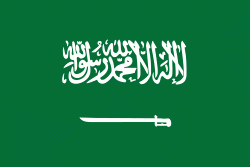Saudi riyal
رس
The Saudi riyal (ريال سعودي ) is the currency of Saudi Arabia. It is abbreviated as ر.س or SAR (Saudi Arabian Riyal). It is subdivided into 100 halalas (هللة ). The currency is pegged to the US dollar at a constant rate of exchange.The riyal has been the currency of Saudi Arabia since the country came into being and was the currency of Hejaz before Saudi Arabia was created, one of the primary currencies in the Mediterranean region during the Ottoman era. The Hejaz riyal was based on but not equivalent to the Ottoman 20 kuruş coin and was consequently divided into 20 qirsh. However, although the Hejaz riyal was the same weight as the Ottoman 20 kuruş, it was minted in .917 fineness, compared to .830 fineness for the Ottoman coin. Thus, because the first Saudi riyal had the same specifications as the Hejaz riyal and circulated alongside Ottoman coins, it came to be worth 22 Ottoman kuruş and was consequently subdivided into 22 ghirsh when coins denominated in qirsh were issued from 1925. The system remained even though the riyal was subsequently debased to a coin equivalent, in silver content, to the Indian rupee in 1935.
In 1960, the system was changed to 20 qirsh to a riyal, which was followed in 1963 by the introduction of the halala, one hundredth of a riyal. Some Saudi coins still bear denominations in qirsh, but it is no longer commonly used.
Country
-
Saudi Arabia
Saudi Arabia, officially the Kingdom of Saudi Arabia (KSA), is a country in Western Asia. It covers the bulk of the Arabian Peninsula, and has a land area of about 2150000 km2, making it the fifth-largest country in Asia, the second-largest in the Arab world, and the largest in Western Asia and the Middle East. It is bordered by the Red Sea to the west; Jordan, Iraq, and Kuwait to the north; the Persian Gulf, Qatar and the United Arab Emirates to the east; Oman to the southeast; and Yemen to the south. Bahrain is an island country off the east coast. The Gulf of Aqaba in the northwest separates Saudi Arabia from Egypt. Saudi Arabia is the only country with a coastline along both the Red Sea and the Persian Gulf, and most of its terrain consists of arid desert, lowland, steppe, and mountains. Its capital and largest city is Riyadh. The country is home to Mecca and Medina, the two holiest cities in Islam.
Pre-Islamic Arabia, the territory that constitutes modern-day Saudi Arabia, was the site of several ancient cultures and civilizations; the prehistory of Saudi Arabia shows some of the earliest traces of human activity in the world. The world's second-largest religion, Islam, emerged in what is now Saudi Arabia. In the early 7th century, the Islamic prophet Muhammad united the population of Arabian Peninsula and created a single Islamic religious polity. Following his death in 632, his followers rapidly expanded the territory under Muslim rule beyond Arabia, conquering huge and unprecedented swathes of territory (from the Iberian Peninsula in the west to parts of Central and South Asia in the east) in a matter of decades. Arab dynasties originating from modern-day Saudi Arabia founded the Rashidun (632–661), Umayyad (661–750), Abbasid (750–1517), and Fatimid (909–1171) caliphates, as well as numerous other dynasties in Asia, Africa, and Europe.
